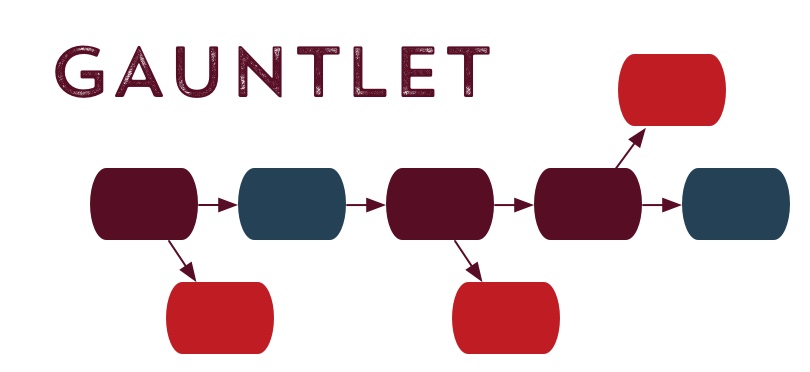
Sometimes I talk to people about common narrative game structures like the ones in
heterogenoustasks.wordpress.com/2015/01/26/sta…
and they get worried because they want to see something that looks like a Hollywood three-act structure.
heterogenoustasks.wordpress.com/2015/01/26/sta…
and they get worried because they want to see something that looks like a Hollywood three-act structure.
Status quo, inciting incident, our protagonist discovers a need to take action, the first few attempts go wrong, the protagonist undergoes some important change or realisation, final attempt succeeds.
B plot, call to adventure, etc., added depending on your particular flavour.
B plot, call to adventure, etc., added depending on your particular flavour.
However! A lot of standard game branching structures are designed so they do produce roughly that narrative flow for the player, especially if you consider reloaded games.
Take your gauntlet, a linear game with potential early deaths.
Take your gauntlet, a linear game with potential early deaths.

Though it looks like a straight line, the player's experience of that story will likely be to try something, die, go back, try the other path (or fight that same challenge more successfully), and succeed. 

It is at least potentially duplicating that structure where the protagonist has to fail and retry.
At the same time, the gauntlet can leave part of the change outside the story.
Often it's the _player's_ retry and the _player's_ learning that cause progress. The protagonist doesn't necessarily experience those things.
So it's not always ideal for telling a character story.
Often it's the _player's_ retry and the _player's_ learning that cause progress. The protagonist doesn't necessarily experience those things.
So it's not always ideal for telling a character story.
Loop and grow structures can do the same, perhaps more reliably. Now maybe the player encounters a version of the challenge multiple times, learning new things each time. (See: run after run after run of Hades.) 

With a little variation, the Loop and Grow can give you a tragedy format where each time the player encounters that challenge, their situation has degraded and they're more likely to fail. This is the format we used for Animal Farm.
A branch and bottleneck, meanwhile, can give you variant mid-story twists or complications to overcome, so now we're asking the player not "do you succeed/fail" but "how and why do you fail the first couple times?"
That can mean more character development within gameplay.
That can mean more character development within gameplay.

Perhaps you are now thinking "I don't see how the Time Cave structure helps with this":
Yeah, the Time Cave's whole aesthetic is that it's an unsystemic mess
Yeah, the Time Cave's whole aesthetic is that it's an unsystemic mess

• • •
Missing some Tweet in this thread? You can try to
force a refresh





